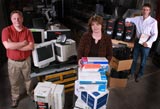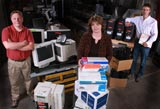
E-Junk is No Joke
National lab shares award-winning strategies for electronics lifecycle management
- By Kami Lowery, Sean Story, John Jagelski
- Jun 13, 2008
 |
Sean Story (from left) of IT services, Kami Lowry of the Pollution Prevention Program, and John Jagelski of Excess and Property Management work together to ensure PNNL purchases environmentally friendly products, donates usable computers that do not meet company standards, and recycles any unusable electronics via the READ contract.
|
The constant quest for faster, more efficient electronics has created an international waste disposal nightmare because electronic components frequently contain lead, mercury, cadmium, and other toxic materials. The need for responsible electronics stewardship is urgent.
There are steps every organization can take now—through comprehensive lifecycle management—to reduce the electronics waste burden. The strategy not only protects the environment, it also offers opportunities to demonstrate leadership, receive internal and external recognition, save money, and track assets more effectively.
The desktop and personal computer program at the Department of Energy's Pacific Northwest National Laboratory demonstrates how an organization can implement electronics lifecycle management.
Adding to the problem
The U.S. government is one of world's largest purchasers of electronics. The Office of Management and Budget reported that federal investments in information technology and services exceeded $65 billion in fiscal year 2006. Every week approximately 10,000 federally owned computers are labeled excess or surplus.
The Federal Electronics Challenge (FEC) is a purchasing, use, and end-of life management call to federal agencies to purchase greener electronic products, manage electronic assets in an environmentally sound manner, and network with other agencies to improve current practices. It is managed by the U.S. Environmental Protection Agency and the Office of Federal Environmental Executive. The Federal Electronics Stewardship Working Group advises the group.
Located in southeastern Washington state, PNNL conducts fundamental and applied research to address national concerns in environment, energy, and national security. The laboratory became an FEC partner in 2006. The program's combination of rigorous standards with comprehensive electronics waste management led PNNL to refocus oversight of electronics and to manage across the entire product lifecycle: acquisition, operations and maintenance, and end-of-life management. In 2007, the laboratory received the program's highest recognition: the Gold Level Award.
Here are some tips for successful electronics lifecycle management.
1. Survey current practices. The FEC Web site offers checklists for assessing your organization's electronics management practices. Use them to examine each phase of the lifecycle.
• Acquisition: procurement of computers, cell phones, copiers, videoconferencing equipment, and other hardware. If your organization leases, can the leases be extended? When purchasing, how does your organization aim for environmentally sound products? How many vendors are used, and do they provide environmentally sound options?
• Operations and maintenance: energy efficiency measures and extending product lifespan. Is the memory upgradeable? How do you handle software updates? Are staff encouraged to turn off computers when not in use?
• End-of-life management: asset management, donations, and recycling. How do you excess equipment, determine that an item is no longer of use to your organization? Where does it go? How do you ensure data security?
2. Set goals. Compare your findings to the FEC criteria to establish your baseline. For each phase of the electronics lifecycle, ask: "What do we need to do?" and "Why aren't we doing it?" The answers will shape your goals and the means to achieve them. Set measurable targets that are realistic and demonstrate meaningful progress when reached.
3. Purchase with prudence. The most environmentally preferable purchasing is no purchasing. Avoid purchasing by upgrading or repurposing existing inventory. In selecting new items, consider lifecycle impacts such as material selection, manufacturing, transportation, use, and disposition.
PNNL requires that new purchases meet the standards of the Electronic Product Environmental Assessment Tool. EPEAT is a system launched in 2006 by the Zero Waste Alliance through an EPA grant. EPEAT researches vendors and identifies manufacturers that meet its standards.
Desktop computers, notebooks, and monitors that meet the required criteria are ranked bronze, silver, or gold, based on 51 criteria set in the public standard IEEE 1680. Among them are energy efficiency (ENERGY STAR® is mandatory), upgradeability, and use of recycled and recyclable materials. More than 20 manufacturers participate in EPEAT, including Apple, Dell, and HP. More than 600 desktops, monitors, and notebooks are registered.
Except for specialized computational resources required for scientific research, PNNL encourages purchase of office computers through an automated electronic purchasing system. From their desktops, staff select pre-screened items. Products not in the system require special approval. Criteria for listed electronics include:
• business justification and significant demand for use,
• EPEAT- and ENERGY STAR-certified,
• LCD, flat-panel monitors only,
• configured to meet a specified lifecycle,
• technology upgrades available (more memory, larger hard drives).
New computer equipment is tagged before delivery to staff members and tracked until it leaves the facility.
4. Reduce energy use. Minimize energy consumption by enabling ENERGY STAR functions. (New equipment vendors can do this before delivery.) Unless there are security or back-up issues, encourage staff to turn off idle computers. Set printers on power-save or turn them off when not in use.
5. Extend the lifespan. Extend the life of computer equipment with technology upgrades. PNNL employs computer rotation to maximize the use of each unit and manages delivery of supported software via a networked system. The laboratory's centralized software distribution tool allows staff to install, upgrade or repair supported software on demand.
6. Engage the right people. Embed lifecycle management requirements into your organization's processes. Set policies where they will be most effective. At PNNL, about 20 individuals in purchasing, information technology, and the excess and redeployment group establish processes used daily by the laboratory's 4,000 scientists and support staff, all of whom periodically take Internet-based property management training.
End-of-life policies mandate that all electronic equipment go through the PNNL excess material and redeployment process, which has detailed procedures for reuse, redistribution, and recycling. Specialized staff address data security and contracts for donation and recycling.
7. Spread the wealth. If a piece of equipment has reached the end of its useable life, and it can't be used elsewhere in the business, consider donating it. PNNL donates computers and other electronic equipment to local schools and communities throughout the nation. In 2006 and 2007, PNNL kept 100 percent of excessed electronic equipment from going to landfills.
Before donating computer or other electronics, always make sure the equipment is usable. Donation organizations have limited, if any, resources and employees to diagnose and repair hardware. Also address data security issues and provide instructions on how to recycle and dispose of the equipment when the recipient can no longer use it.
8. Recycle, recycle, recycle. When electronic equipment is beyond upgrade or refurbishment and is not suitable for donation, it's time to recycle. Finding a responsible recycler is key to closing the lifecycle loop. PNNL piggybacks on an electronics recycling contract offered by EPA's Recycling Electronic and Asset Disposition program. READ sets standards and evaluates contractors. Criteria: recycle as much as possible; properly dispose of the remainder. An audit trail of the equipment's final destination ensures that reclamation and recycling efforts are reportable.
"Whether we have a thousand computer systems or only one cell phone, all of us have an opportunity – and an obligation – to reduce the environmental impacts of electronics," said Jeff Eagan, Electronic Stewardship coordinator for DOE's Office of Environmental Policy and Assistance. "The Department of Energy is committed to becoming a leader in electronic stewardship among federal agencies. If every organization made and followed through on a similar commitment, we greatly improve the electronic waste situation here and abroad."
About the Authors
Kami Lowery is Environmental Management & Pollution Prevention Integration manager at Pacific Northwest National Laboratory.
Pacific Northwest National Laboratory is a DOE Office of Science national laboratory that solves complex problems in energy, national security, and the environment, and advances scientific frontiers in the chemical, biological, materials, environmental, and computational sciences. PNNL employs 4,000 staff, has a $760 million annual budget, and has been managed by Ohio-based Battelle since the lab's inception in 1965.
Sean Story is Managed Hardware Program manager at Pacific Northwest National Laboratory.
John Jagelski is Excess & Redeployment Services manager at Pacific Northwest National Laboratory.